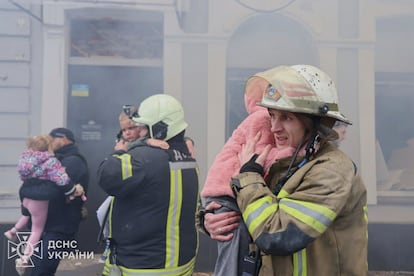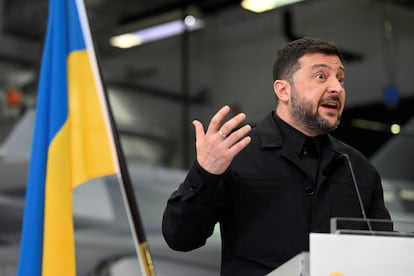No one wants the war in Ukraine to last 100 years, said renowned American political scientist George Friedman at a conference in Kyiv on October 16. But its protagonists are racing at different speeds to end it. Speeds that are incompatible.
Russian President Vladimir Putin has demonstrated that he has the upper hand in the diplomatic arena. The postponement of the summit that US President Donald Trump announced with Putin in Budapest for this October is the latest example of Russia's strategy: to bog down negotiations and maintain a long-term conflict that is primarily about attrition on the battlefield.
Trump's strategy is to end the conflict at all costs and claim credit for what he considers to be the ninth war, according to his personal count, in which he has successfully intervened as a mediator. But the Kremlin made it clear that the possible meeting in Hungary requires more preparatory work. The Republican admitted on Tuesday that his rush to hold the summit had clashed with Moscow's maximalist proposals, and that he, too, does not want"a useless meeting." The US leader confirmed on Thursday that he was canceling the summit but hopes to hold it in the future.
The White House's expected preparatory meeting this week between US Secretary of State Marco Rubio and Russian Foreign Minister Sergey Lavrov was also postponed. Lavrov reiterated Tuesday that Russia is not in favor of a ceasefire because it"would not bring lasting peace" and because it "would leave a vast part of Ukraine under the control of a Nazi regime." Russian propaganda portrays Ukraine as a country controlled by a neo-fascist elite. Russia's constitution unilaterally included the Ukrainian provinces of Donetsk, Luhansk, Kherson, and Zaporizhia as part of its federation in 2022. It illegally annexed the Crimean peninsula in 2014.

But Trump's interests have not only clashed with Putin's, but also with those of Ukrainian leader Volodymyr Zelensky. The US president has demonstrated that any option that aims to end the war as quickly as possible is valid, whether Moscow's position (that Ukraine surrender sovereignty over the occupied territories) or kyiv's (that an unconditional ceasefire be declared before any negotiations).
Trump pressured Zelensky last Friday at the White House to agree to negotiate the distribution of territories. That same Friday, the leaders of the major European powers came to Ukraine's aid in public statements. The European voice, in unison, materialized this Tuesday in a statement in which the EU's major partners and the United Kingdom asked Trump to support the need to freeze the front in a ceasefire before Ukraine and Russia sit down to negotiate peace:"We strongly support President Trump's position that the fighting must stop immediately, and the current front line must be the starting point for negotiations."
European alignment with kyiv will be reaffirmed this Thursday in Brussels, where Zelensky will participate in the European Council meeting, and on Friday, at a summit of Ukraine's military allies in London.
An engine with less horsepower
Zelensky is aware that the Ukrainian engine has fewer horsepower than the Russian one; that is, fewer resources to fight. That's why he's been repeating for months that the war should end before the end of the year. His Armed Forces have heroically managed to limit the Russian advance, but that advance continues. The Ukrainian arms industry has increased its production almost tenfold during the war, as Volodymyr Vlasiuk, economist and government advisor, explained to a group of journalists last week. But this is not enough to resist, which is why European and American support is essential, especially with more technologically advanced weapons and anti-aircraft systems.

The problem is that this assistance is faltering, especially due to Trump's policy of eliminating all military aid to Ukraine unless first purchased by NATO allies. This has meant that monthly arms transfers to the Ukrainian army have dropped 43% compared to the first half of the year. The White House also refuses to provide Kiev with long-range Tomahawk missiles, arguing that it would be an unnecessary escalation of tensions with Moscow.
Something similar happened last August when Trump received Putin with full honors in Alaska, convinced that the summit would be a decisive step toward peace. At that meeting, the Russian autocrat managed to halt US plans to impose new sanctions on the Russian economy, promise Trump bilateral trade agreements, and reset the clock on the end of the war.
This Washington appeasement strategy is incompatible with Ukraine's position, which believes peace is only possible if it is given much stronger defense guarantees than what it has received so far, such as the Tomahawk missiles. Trump also won the 2024 presidential election by promising at virtually every rally to end aid to Kyiv, considering it wasteful.
Sanctions against Russia
In Trump's unpredictable logic of abruptly moving closer to or further from one side to the other, US Treasury Secretary Scott Bessent announced Wednesday night that the White House would apply new sanctions against Russia, the first under the Republican presidency. The US president, in an appearance alongside NATO Secretary General Mark Rutte, confirmed that his government, after months of waiting, will finally introduce sanctions against the Russian oil industry, the main source of income for the Kremlin's war machine."Every time I talk to Vladimir [Putin], we have a good dialogue, but then they don't go anywhere," Trump explained.
“I hope Putin ends up being reasonable, and I hope Zelensky ends up being reasonable too. As they say, it takes two to tango. But these two people hate each other,” Trump added.
Kremlin spokesman Dmitry Peskov insisted Wednesday that Putin wants to hold the summit with Trump in Hungary, but that the meeting needs more time to prepare. Peskov asserted that both kyiv and European powers are trying to"interfere" with the US position to derail the meeting.
“I have serious doubts that the Budapest meeting will actually take place, as it would not bring us any closer to peace,” Oleksandr Merezhko, chairman of the Ukrainian parliament’s foreign affairs committee, told the Telegraf newspaper. “Putin will never accept the possibility of a ceasefire because it gives Ukraine a chance to survive and develop. He will only accept our capitulation.”
Despite kyiv's desire for Trump to distance himself from Putin, prominent Ukrainian analysts also assume that a new summit between the Russian and American leaders will eventually take place."My intuition tells me that Trump's next meeting with Putin will take place, either in Budapest or somewhere else," Volodymyr Gorbach, director of the Institute for the Transformation of North Eurasia, wrote in an analysis on Tuesday."Putin understands and feels that Trump needs him much more than he needs him. That's why he negotiates, bargains, and avoids him again, and by doing so alone, he's buying time."

